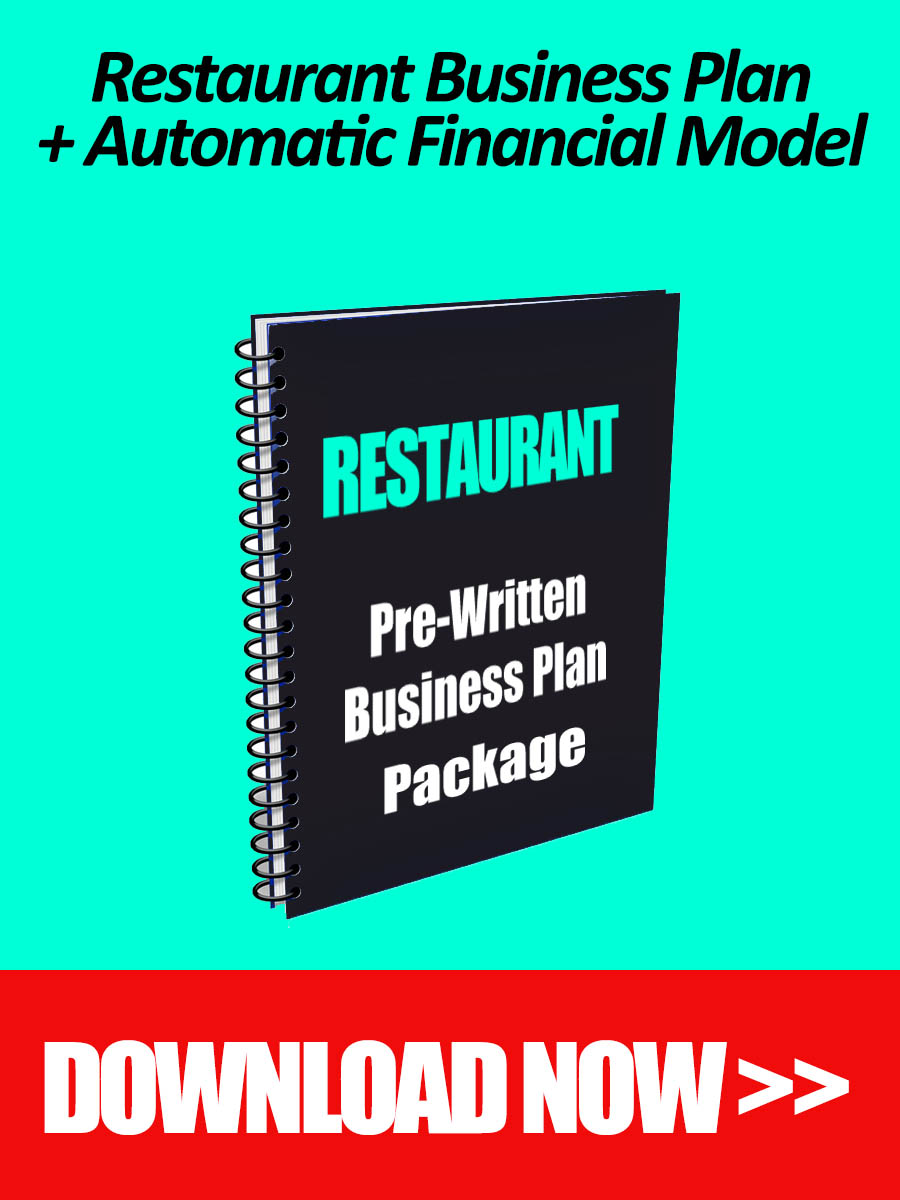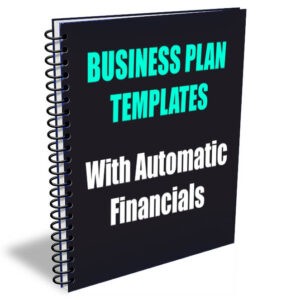There you stand right now — at the cusp of realizing your dream of launching your own restaurant. You have a great business idea in mind, and your core team is just as enthusiastic about making this F&B venture a success as you are. But do you have a restaurant business plan ready? If not, your restaurant dream may remain just that — a dream.
A restaurant business plan gives you the framework to help you piece together each and every thing — from the menu design and sitting arrangements to restaurant management. It also serves as a roadmap, telling you whether you are moving in the right direction or not.
In short, a thorough business plan is crucial to the success of your restaurant.
Before we get started, you might be interested to check out our Ready-made Restaurant Business Plan Template with pre-written text and automatic financials which you can easily customize and adapt to your own project, no financial expertise required.
So what does a restaurant business plan entails? How does one write it? Why do you need a plan at all in the first place? Do you need a business degree to pen one?
The answer to the last question is a definite “NO.” And to find out the answers to the first three, continue reading…
The Sections to Include in a Restaurant Business Plan
You should include the following sections in your restaurant plan:
1) Executive Summary
2) Description of your Business
3) Market Analysis
4) Your Restaurant’s Menu
5) Employees
6) Design of Your Restaurant
7) Its Location
8) Overview of the Market
9) Marketing
10) External Help
11) Financial Forecast
Why Do You Need A Restaurant Business Plan?
Writing a well-thought-out business plan takes time and effort, and while the process may be a little complex and time-consuming, without a well-written restaurant business plan, you are reducing your chances to succeed and investors won’t give you the time of day, much less their money. And even if you do manage to get the funds, without a proper plan, you are likely to be off to a rough start.
Your restaurant business plan shows:
– How you will turn your venture into a profitable, sustainable business
– Where exactly your restaurant concept fits in the F&B market
– How you plan to stand out from the rest
Spending a little time early on creating a sound business plan is every bit worth the reward of a successful and sustainable restaurant business in the long run.
Writing A Restaurant Business Plan Made Easy
Here are some main steps you must take care of while creating a restaurant business plan.
Executive Summary
Your business plan should always — we repeat always — start with a powerful executive summary.
Why? Glad you asked.
A good executive summary does two things:
Introduces the reader to your restaurant business plan
Provides a summary of your entire F&B business idea
And both of them are important things. Remember, investors are not going to read a 30-page long business plan unless you convince them upfront that it will be worth their while.
An executive summary gives you the opportunity to do just that. In short, it helps you draw in the reader.
So what are the common components of a good executive summary?
If you want to write a compelling executive summary, make sure you have all these sections.
– Mission Statement
– Proposed F&B Concept
– Execution
– Startup Costs
– Expected Return on Investments (ROI)
If you’re looking for funding, it’s absolutely imperative your restaurant business plan includes and starts with a powerful executive summary. Investors aren’t going to comb through your entire plan to get information; if you don’t provide them key information upfront, they are more likely to simply toss away the plan than read it.
Here are some tips to help you create a compelling executive summary:
Keep it short and simple
Remember, an executive summary is not referred as summary for nothing. It is not the place where readers expect in-depth analysis. Instead, the reader wants you to tell him what your business does in just a couple of pages, even a single page if possible.
Lead with a problem and its solution
What needs is your restaurant fulfilling? Who has these needs? And how exactly you plan to address them?
If you want the investor to read your entire summary, ensure you list the unique value proposition of your F&B concept. Investors are not interested in nice to-have solutions and consumers with little money, even less in history lessons and your vision to make the world a better place.
So share the most important part in the beginning itself, but be concise and to-the-point.
Focus on what makes you different
What is about your restaurant that makes it stand out? It could be the type of cuisine you offer, or the quality of the ingredients you source, or maybe the edgy décor of your venue. Focus on answering this question here. And remember to back your claims with hard facts.
Show why your team is the best one for this F&B project
Investors back the right team before anything else. So make sure you mention your most important players here, as well as their previous experience in the F&B business.
Show the market opportunity is large and growing
Investors want to see dependable third-party evidence that your market opportunity is not only large but also has an impressive growth rate. When it comes to the type of cuisines or restaurant concepts, this implies choosing the right niche that promises a significant growth in demand. A thorough market research can prove very useful to identify and understand the F&B opportunity.
Define your business model
Quantify each and every important element of the equation. This includes price, volume, and margin, among others. Remember that a fast-food outlet has a totally different business model compared to a fine dining restaurant. Make sure you truly understand the financial dynamics that lie behind your operations.
Project revenues, your costs, and your investment expectations
What targets have you set for yourself? It is paramount to understand your cost and revenue forecasts. Only mention a summary of your key financials at this stage. This could be done with a chart and a summary table for example. You will later develop in detail your pro-forma financial statements including P&L, Cash Flows and Balance Sheets in a dedicated section of the business plan.
Additionally, mention the amount of investment you need to launch and grow your F&B venture.
Highlight the potential return
This is where you outline the payback process and the potential return on investment. This is usually developed as part of your financial plan section. Investors are keen to know when and how much return they get for the investment they will inject in your F&B venture.
Restaurant Description
This section is typically divided into two parts. The first part should include the following information in this section:
– Name of your restaurant
– Its location
– Owner’s details
– And a small description of their relevant experience
In the second part of your restaurant description section, include the following information:
– Outline short-term goals and long-term goals
– Outline the legal standing of your restaurant
– Give a short market study to highlight your understanding of the regional food industry trends. Also include the reasons that make you believe that your restaurant will be a success
Market Analysis
You should talk in detail about the micro conditions in the locality where you plan to open a restaurant, as well as the macro conditions.
If any current economic conditions may make opening a restaurant difficult, mention them as well, along with how you plan to tackle them. List the restaurants with which your business will compete and your strategy for combating them.
Generally speaking, the market analysis section comprises two parts.
Industry Analysis
Start with global trends in the F&B sector then drill down to your particular niche in the local market.
Define your target market in this section. Also, tell the investors what demographics your restaurant will be catering to.
The aim of this section is to present the latest consumer trends and explain the target market to the reader while underlining the reasons why customers would want to visit your restaurant.
The restaurant industry is a highly competitive market, and it is important to conduct a thorough market analysis to identify opportunities and threats. The latest trends in the industry include:
Health and wellness: Consumers are becoming more conscious of the food they eat and are looking for healthier options. This includes an increased demand for organic, non-GMO, and locally sourced ingredients. Restaurants that offer dishes made with these types of ingredients will be at a competitive advantage. Additionally, more customers are looking for menu options that are low in calories, fat, and sugar.
Plant-based options: The demand for plant-based options is on the rise, and many restaurants are starting to offer more vegetarian and vegan options on their menu. This trend is driven by concerns over health, environmental impact, and animal welfare. Restaurants that can provide delicious and varied plant-based options will attract a wider range of customers, including vegetarians, vegans, and those who are simply looking to reduce their meat consumption.
Delivery and take-out: With the rise of food delivery apps, more and more consumers are choosing to have their meals delivered or to pick them up for take-out. Restaurants that offer these options are at a competitive advantage. This trend is driven by convenience and the ability to have restaurant-quality food in the comfort of one’s home. Restaurants should ensure that the food holds up well during delivery and that the packaging is suitable for take-out.
Technology: Restaurants are starting to adopt technology to enhance the customer experience, including online ordering, mobile payments, and digital menus. Technology can also help with inventory management and customer relationship management. Restaurants that can provide a seamless and convenient experience through technology will attract customers who are looking for a quick and easy process.
Personalization: Consumers are looking for personalized experiences, and restaurants are responding by offering customizable menu options and personalized service. Customers may want to make adjustments to dishes to fit their dietary restrictions, or they may want to have a unique experience tailored to their tastes. Restaurants that can provide this level of personalization will be able to attract and retain customers.
Farm-to-table: An increasing number of customers are looking for meals made with locally-sourced, fresh ingredients. This trend is driven by concerns over health and environmental impact, as well as a desire for a more authentic dining experience. Restaurants that can provide dishes made with locally sourced ingredients will be able to differentiate themselves from competitors and attract customers who value this type of experience.
Finally, you can also include a SWOT analysis for your restaurant project. This is basically analyzing the Strengths, Weaknesses, Opportunities and Threats involved in running your F&B project. If you wish to learn more about how to conduct a SWOT analysis for a restaurant, check our detailed guide here.
Competition Analysis
More than anything else, investors want to know what makes your restaurant different and how does it stack up against the competition. Show investors you’ve researched the market and competition thoroughly. Then explain why your F&B venture will be different. Highlight the local gaps and demonstrate how your unique offering will make you stand out from the rest.
This section should provide an overview of the competitive landscape and should include the following:
Direct competitors: Identify the main competitors in the area, including their location, menu, prices, and target market. This information can be gathered through online research and by visiting the competitors’ establishments.
Market share: Estimate the market share held by each direct competitor. This information can be found through industry reports, online research, and by conducting surveys of customers.
Competitive advantage: Identify the unique selling points of the restaurant, and compare them with the strengths of the direct competitors. This will help to identify the restaurant’s unique advantage over its competitors.
Barriers to entry: Identify any barriers to entry that may make it difficult for new competitors to enter the market.
Menu
It’s no secret that the key element to starting your restaurant is the menu. That said, you don’t need the final version of your menu for your business plan; a mock-up would do just fine. However, walking into a meeting with an investor without a sample menu is a strict no-no.
Also, ensure your sample menu is designed professionally and has your logo on it. In case you don’t want to yet shell out money on menu design, use one of the online resources. There are many resources available online, most of which are pretty easy to use. This means you wouldn’t have to put in a lot of effort or time to create the menu’s design.
Pricing is the most important element of your mock-up menu. Your rates should be in line with your cost analysis, as this will allow investors to get a clear understanding of your target price point.
Employees & Hiring Plan
In the company description section, you introduced the owners to the investors. Now is the time to flesh out your restaurant management team. While investors certainly don’t expect you to have filled every position just yet, they would prefer to see at least a few members of the core team on board.
A good idea is to have a table showing the various positions you plan to hire with average salaries and expected start dates.
This section should include the following:
Staffing needs: Identify the number of employees needed for the restaurant, including the positions that need to be filled and the hours of operation. This information should be based on the restaurant’s projected sales and the number of customers expected.
Job descriptions: Provide detailed job descriptions for each position that needs to be filled. This should include the responsibilities, qualifications, and experience required for each position.
Recruiting plan: Outline the plan for recruiting and hiring employees, including the methods that will be used to attract potential candidates, such as online job postings, recruiting events, and employee referrals.
Hiring criteria: Describe the criteria that will be used to evaluate candidates, including qualifications, experience, and references.
Training: Describe the training that will be provided to new employees, including both on-the-job training and any additional training that may be required.
Employee retention: Describe the strategies that will be used to retain employees, including competitive compensation, benefits, and opportunities for advancement.
Legal compliance: Ensure that the hiring process, compensation, and benefits are compliant with all applicable federal, state, and local laws and regulations.
The typical roles needed in a restaurant include:
Front-of-house: These roles include servers, hosts/hostesses, bartenders, and bussers. They are responsible for providing excellent customer service, taking orders, serving food, and ensuring that customers have a pleasant dining experience.
Back-of-house: These positions include cooks, dishwashers, and prep cooks. They are responsible for preparing food, keeping the kitchen clean, and ensuring that the food is prepared to the highest standards.
Management: These include the restaurant manager, assistant manager, and kitchen manager. They are responsible for overseeing the day-to-day operations of the restaurant, managing staff, and ensuring that the restaurant is running efficiently and profitably.
Support roles: These roles include bookkeeping, inventory management, marketing and human resources. They are responsible for maintaining financial records, purchasing supplies, and ensuring that the restaurant is in compliance with all applicable laws and regulations.
Additional roles: Depending on the type of restaurant, additional positions may be needed, such as a pastry chef, sous chef, wine steward and delivery driver.
Restaurant Design (optional but highly recommended)
This is the section where you can impress investors with your creativity. Ideally, you should showcase an attractive mock-up rendering of your restaurant, but if you don’t have one, that’s fine too. You can use a mood board to convey your vision and ideas.
However, remember that there’s more to restaurant design than aesthetics alone. In your sample design, cover everything, from décor to kitchen equipment.
Location
Have you already chosen the location for your restaurant? Is it appropriate for your target market? These are two important questions you should answer in this section.
But what if you haven’t picked the precise location yet?
Well, this is a common scenario especially in the case where you’re still looking for funding. That said, by now you should have at least a few location options in your mind. So talk about them, but don’t just rattle off the names of every shortlisted location one by one. Instead, include as much information about each location as possible to show investors just exactly why it would be great for your restaurant idea. Mention every important detail, from typical demographics to square footage or seating capacity.
Marketing
This is where you tell the investors in detail how you plan to market your restaurant to your target audience.
Will you be relying on traditional marketing strategies or do you plan to embrace digital media and mobile technology to spread the word about your restaurant? Give a detailed overview of each of your marketing strategy and why you’ve chosen it.
Some of the marketing strategies worth considering in the current landscape of restaurant business include leveraging social media platforms, creating a smart and user-friendly website, offering contests, utilizing email marketing, reaching out to food bloggers and influencers, and getting listed on popular F&B portals and review sites.
Here is what you should include in your restaurant’s marketing plan:
Marketing strategies: Outline the strategies that will be used to promote your restaurant, such as advertising, public relations, promotions, and social media. These strategies can be used to create a brand image and awareness, create a buzz and attract new customers and encourage repeat business.
Marketing tactics: Here, describe the specific tactics that will be used to implement the marketing strategies, such as creating print ads, launching a website, offering discounts or special deals, and using social media platforms. These tactics can be used to reach and engage with the target market, and create a call-to-action that would drive customers to the restaurant.
Advertising budget: Next, provide an estimate of the budget that will be allocated to advertising and promotions, and explain how the budget will be allocated across different tactics. This would include considering the cost-effectiveness of each tactic, and making sure that the budget is allocated in a way that would maximize the return on investment.
Measurement and analysis: The next step would be identifying the metrics that will be used to measure the effectiveness of the marketing plan, and describing how the results will be analyzed. This would include setting clear goals and objectives, and using metrics such as customer acquisition, customer retention, and revenue to track progress and make adjustments as needed.
Continual improvement: Finally, explain how the marketing plan will be reviewed and updated on a regular basis to ensure that it is still aligned with the restaurant’s goals and that it continues to be effective. This would include monitoring the market trends, customer feedback, and competitors’ activities to make sure that the plan is still relevant and responsive to the business needs.
External Help
You are likely to need help to turn your dream of owning a successful restaurant into reality. List all the help you are planning to hire in this section. This includes everything from F&B consultants, designers and accountants to suppliers and software that will help you run the restaurant more efficiently, such as restaurant reservation software and POS systems.
Financial Plan, a Key Section in your Restaurant Business Plan
The financial section is one of the most important components of your restaurant business plan, and you should give it the attention it deserves.
To be able to properly forecast your restaurant financials, aim to answer the below questions:
– The number of seats your restaurant is likely to have
– The average check per table based on the average prices of your key menu items (starters, main dishes, desserts and beverages)
– The average number of guests per day
You should also do rough food cost calculations for each menu item, as this will allow you to estimate the profit margin on every dish. You can do these calculations easily with the help of a free online food cost calculator.
The purpose here is to build a pro-forma income statement, cash flow statement and balance sheet.
These financial statements will allow you and potential investors to understand the cost and revenue projections of your restaurant over the next three years. It will also help you estimate the profitability of your F&B venture.
The Profit and Loss (P&L) forecast, also known as an Income Statement, is a key part of the financial plan. It is a projection of the restaurant’s revenues, expenses, and profits over a specific period of time. This statement typically includes the following components:
Revenue: Projected revenues from sales of food and beverages, including any additional revenue streams such as catering or private events.
Cost of goods sold (COGS): The projected cost of ingredients, supplies, and other direct expenses related to the production of food and beverages.
Gross profit: The difference between revenue and COGS, which represents the restaurant’s gross margin.
Operating expenses: Projected expenses for things like rent, utilities, labor, marketing, and insurance.
Net profit: The difference between gross profit and operating expenses, which represents the restaurant’s bottom line.
The cash flow statement and balance sheet are also important financial statements in a restaurant’s business plan. The cash flow statement shows the inflow and outflow of cash over a specific period of time and can help to identify potential cash flow issues and plan for future financing needs.
The balance sheet shows the restaurant’s assets, liabilities and equity at a specific point in time and can help to understand the company’s liquidity, solvency and net worth. Both statements are important tools for monitoring the financial performance of the restaurant, and should be regularly reviewed and updated to reflect actual results, and to make any necessary adjustments to the budget and financial plan.
For more detailed information about a restaurant’s financials, we highly recommend you consult our financial plan guide dedicated to the restaurant business.
Your Restaurant Business Plan: Final Words
If you want your restaurant to be a success, you must plan properly. In other words, you need a well-thought-out restaurant business plan. Don’t worry, you don’t need a business degree to write one. Just follow the tips shared above, and you will do fine.
Alternatively, if you are short on time and want an ultra fast and cost-effective solution, then we recommend you download our ready-made restaurant business plan template with automatic financials. All you need to do is spend a couple of hours customizing our pre-written Word template and filling some assumptions in the Excel spreadsheet to generate an investor-grade restaurant business plan with financials in record time.






